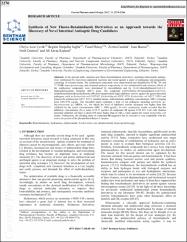Synthesis of New Fluoro-Benzimidazole Derivatives as an Approach towards the Discovery of Novel Intestinal Antiseptic Drug Candidates

View/
Access
info:eu-repo/semantics/openAccessDate
2017Author
Çevik, Ulviye AcarSağlık, Begüm Nurpelin
Özkay, Yusuf
Cantürk, Zerrin
Bueno, Juan
Demirci, Fatih
Koparal, Ali Savaş
Metadata
Show full item recordAbstract
In the present study, nineteen new fluoro-benzimidazole derivatives, including nifuroxazide analogs, were synthesized by microwave-supported reactions and tested against a panel of pathogenic microorganisms consisting of resistant strains. The synthesized compounds were characterized and identified by FT-IR, H-1- and C-13-NMR, mass spectroscopy, and elemental analyses, respectively. In vitro antimicrobial and cytotoxic effects of the synthesized compounds were determined by microdilution and by [3-(4,5-dimethylthiazol-2-yl)-2,5diphenyltetrazolium bromide] (MTT) assay. The compound 4-[5(6)-fluoro-1H-benzimidazol-2-yl)-N'-(2methylbenzylidene)] benzohydrazide (18) showed particularly high inhibitory activity against the gastro-intestinal pathogens, such as Escherichia coli O157:H7, Escherichiacoli ATCC 8739, Escherichia coli ATCC 35218 and Salmonella typhimurium ATCC 13311 standard strains, with minimum inhibitory concentrations (MIC90) ranging from 0.49-0.98 mu g/mL. The microbial panel contained a total of ten pathogens including Klebsiella sp., Mycobacterium sp., MRSA, etc., for which the level of inhibitory activity measured was higher than that exhibited by the tested concentrations (MIC > 1000 mu g/mL). In vitro cytotoxicity results revealed that the inhibitory concentration (IC50) value (210.23 mu g/mL) of compound 18 against CCD 841 CoN cells (human intestinal epithelial cell line) is about 430 times higher than its MIC90 value against the tested Escherichia coli strains. Furthermore, the docking study of compound 18 suggested that its structure is very compatible with the active site pocket of the phosphofructokinase-2 enzyme.

















